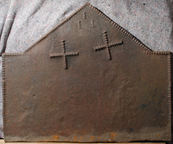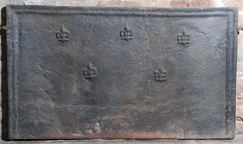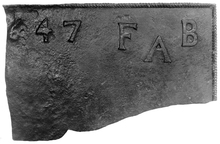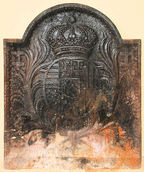-
1021
Description: Rectangular; cavetto-moulded edging; shield mounted on a strap-work cartouche, helm, crest, motto scroll and elaborate swirled mantling.
Notes: The arms of the Ironmongers' Company; blazon: Argent, on a chevron gules, between three gads of steel azure, three swivels or; crest: two talbots combatant encoupled together or. The true crest of the company has two salamanders (originally 'scaly lizards') rather than talbots, and it has been noted on other firebacks that salamanders are not always represented as amphibians; Samuel Lyne, in his Heraldry Display'd (1741), described the crest as 'two talbots', etc. The motto scroll is blank, indicating that the pattern was an armorial panel with a painted, rather than a carved, motto. A variant of the same fireback has the date 1660 and initials GI (Country Life, 8 March 1946, p. 450; 29 March 1946, p.588). Reeman Dansie auction, Colchester, 13 Apr 2016, lot 1224; Bellman's auction, Wisborough Green, 13 Oct 2021, lot 588 (£220).
Copies of this fireback are known.
Arms: Worshipful Company of Ironmongers
- Decoration tags:
- rectangular (shape)
- cavetto (edging)
- whole carved pattern
- armorial
Manufactured: in the mid-17th century in England.
Current location: not known.
- Attached to series:
- Livery company firebacks
- Armorial panel firebacks
-
958
Description: Rectangle with triangular arch; twisted rope edging (top and sides); centre top, initials in triad, E above; two twisted rope crosses irregularly spaced below initials.
Notes: The initials, probably of a husband and wife, show minimal extension in the horizontal, although the 'I' has a stud halfway; the crosses almost certainly have an apotropaic purpose; the depth of the casting varies between the top, where it is thickest, and the bottom. Bellman's auction, Wisborough Green, 13 Oct 2021, lot 589 (£420).
Inscription: IEL [triad]
- Decoration tags:
- rectangular with triangular arch (shape)
- rope (edging)
- simple stamps
- carved stamps
- apotropaic
- text
Manufactured: in the late-16th to early-17th century in England.
Current location: not known.
- Attached to series:
- Rope design firebacks
-
829
Description: Rectangular; ovolo-moulded edging (top and sides); repeated guilloche pattern inside top and side edges; upper centre, lozenge stamp with ovolo edges and recessed daisy flower in centre, between buckle stamp repeated twice; the lozenge stamp is repeated over-stamping the lower part of the first.
Notes: The lozenge stamp is a design also seen on domestic interior panelling; the buckles suggest a Pelham family association; the buckle and lozenge are separate stamps, and in each example their relative positions differ slightly; the guilloche design appears to have been carved on the base panel; an example at The Star Inn, Alfriston, Sussex measures 665mm x 480mm.
- Decoration tags:
- rectangular (shape)
- ovolo (edging)
- carved stamps
- carved pattern panels
- heraldic
- objects
Manufactured: in the early- to mid-17th century in the Weald area of England.
Current location: in private hands, Iford, East Sussex, England.
- Attached to series:
- Pelham family firebacks
- Pelham buckle and lozenge series
- Metalware stamp firebacks
-
830
Description: Rectangular; stepped fillet moulded edging (top and sides); small fleur-de-lys stamp repeated five times, three centred across the top, two centred across the middle.
Notes: The fleur-de-lys stamp appears to have been constructed using wire.
- Decoration tags:
- rectangular (shape)
- stepped fillet (edging)
- carved stamps
- heraldic
- objects
Manufactured: in the mid- to late-16th century in the Weald area of England.
Current location: in private hands, Iford, East Sussex, England.
- Attached to series:
- Miscellaneous stamp firebacks
-
1136
Description: Fragment; rectangular; twisted rope edging; top centre, date [1]647; top right, initials FAB in triad, A below F and B.
Notes: The initials were probably mirrored on the left side. Acquired from a location at Tintern, Monmouthshire. A fireback of near identical design and provenance was noted by David Bick at Poolway House, Coleford, Gloucestershire (Gloucs. Archives D9104).
Inscription: 647 FAB [triad]
- Decoration tags:
- rectangular (shape)
- rope (edging)
- individual letters
- individual numbers
- text
Manufactured: in 1647 probably at Tintern Furnace in the Forest of Dean area of Wales.
Current location: National Museum Wales, National Collections Centre, Heol Crochendy, Parc Nantgarw, Nantgarw, Glamorgan, Wales.
Museum number: 73.25I (part of the National Museum Wales museum group)
- Attached to series:
- Date & initials firebacks
-
470
Description: Rectangular; twisted rope edging (top and sides); central Tudor royal shield with encircling garter (motto reversed), separate greyhound and lion supporters, separate crown; rectangular bordered stamp with an animal facing to the right, repeated once above and on each side of the armorial; bold fleur-de-lys stamp repeated once on each side of the armorial below the other stamp; all irregularly positioned.
Notes: The armorial and fleurs-de-lys are seen together on a plate at Alfriston Clergy House.
Copies of this fireback are known.
Arms: Tudor royal (prob. Henry VIII)
- Decoration tags:
- rectangular (shape)
- rope (edging)
- carved stamps
- heraldic
- armorial
- royal
- objects
Manufactured: in the early- to mid-16th century possibly at Pounsley Furnace, Framfield in the Weald area of England.
Current location: not known.
Citation: Lloyd, N., 1925, 'Domestic Ironwork I', Architectural Review, 58, pp. 58-67.
- Attached to series:
- Pounsley series
- Tudor royal armorial firebacks
-
820
Description: Arched rectangular shape; wide fillet and egg-and-dart ovolo edging; central oval armorial with fillet edging, palm fronds on each side, tied below, a crown above; in each top corner, the cross of Lorraine.
Notes: The arms are those of Duke Leopold I of Lorraine, who also bore the titles of King of Jerusalem, Hungary and Aragon, and Duke of Anjou, Bar, Gueldre and Juliers.
Arms: Leopold I, Duke of Lorraine and Bar (1680-1729)
- Decoration tags:
- rectangular with round arch (shape)
- ovolo, egg and dart (edging)
- whole carved pattern
- armorial
Manufactured: in the early-18th century possibly in the Lorraine area of France.
Current location: not known.
- Attached to series:
- Foreign armorial firebacks
-
909
Description: Arched rectangular shape; cavetto-moulded edging;lower centre, crowned bust of King William III above a cartouche, possibly orange branches, with leaves and fruit on each side; above, a putto blowing a trumpet; initials on each side of cartouche; date split between bottom corners.
Notes: A finely detailed image of King William III; the significance of initials is not known. It is possible that the bust of the king, the date, initials and the surrounding branches were carved on a separate pattern which was added to an otherwise simple mould comprising an arched rectangular border and the trumpet-blowing putto before casting. Christie's auction, 25 Feb 2014, lot 184 (£6,000).
Copies of this fireback are known.
Inscription: 16 96 / AC AL
- Decoration tags:
- rectangular with round arch (shape)
- cavetto (edging)
- whole carved pattern
- individual letters
- individual numbers
- historical
- royal
- text
- humans
- plants
Manufactured: in 1696 in England.
Current location: not known.
- Attached to series:
- Miscellaneous royal firebacks
-
952
Description: Rectangular joined to pediment by symmetrical scrolls; fillet edging with embattling inside; shield, helm, crest, supporters and mantling of the city of Bristol; date split by bottom of shield; inscription in an oval cartouche below shield; rectangular side extensions with twisted rope edging; initial on each extension.
Notes: The mismatched ‘3’ in the date is likely to have replaced a ‘1’ or ‘2’. The pattern-maker was also responsible for carving royal coats of arms in three West Country churches and a small number of series of firebacks in the first quarter of the 17th century. A variant without the side extension panels is no. 355.
Inscription: T H / 16 34 / ARMES BRISTOLL
Arms: City of Bristol
- Decoration tags:
- rectangular with detached pediment (shape)
- fillet and rope (edging)
- whole carved pattern
- individual letters
- individual numbers
- planklines
- extension panels
- armorial
- text
Manufactured: in 1634 possibly in the Forest of Dean area of England.
Current location: not known.
- Attached to series:
- Civic firebacks
- Bristol armorial group
-
699
Description: Rectangular; twisted rope edging on top and sides; cavetto-moulded-edged rectangle top centre, enclosing date between initials; 16 shields of Ayloffe impaling Sulyard in three rows (5-6-5); Ayloffe: sable, a lion rampant Or, collared gules, between three crosses formy of the second; Sulyard: argent, a chevron gules between three pheons inverted sable.
Notes: William Ayloffe (c1535-1584) of Bretons, Hornchurch, Essex, Justice of the Court of Queen’s Bench, married (c1560) Jane, dau. of Sir Eustace Sulyard, of Runwell, Essex. The initials 'CT' are likely to be those of Charles Tyler, a founder whose working life and that of his family have strong parallels with the occurrence of these firebacks. Indentations in the spaces in the upper parts of this fireback appear to impressions of fingers.
Copies of this fireback are known.
Inscription: C.1.6.0.1.T
Arms: Ayloffe impaling Sulyard (William Ayloffe of Bretons, Hornchurch)
- Decoration tags:
- rectangular (shape)
- rope (edging)
- carved stamps
- individual letters
- individual numbers
- armorial
- text
Manufactured: in 1601 possibly at Bedgebury Furnace, Goudhurst in the Weald area of England.
Current location: not known.
- Attached to series:
- Ayloffe series
- Personal armorial firebacks









